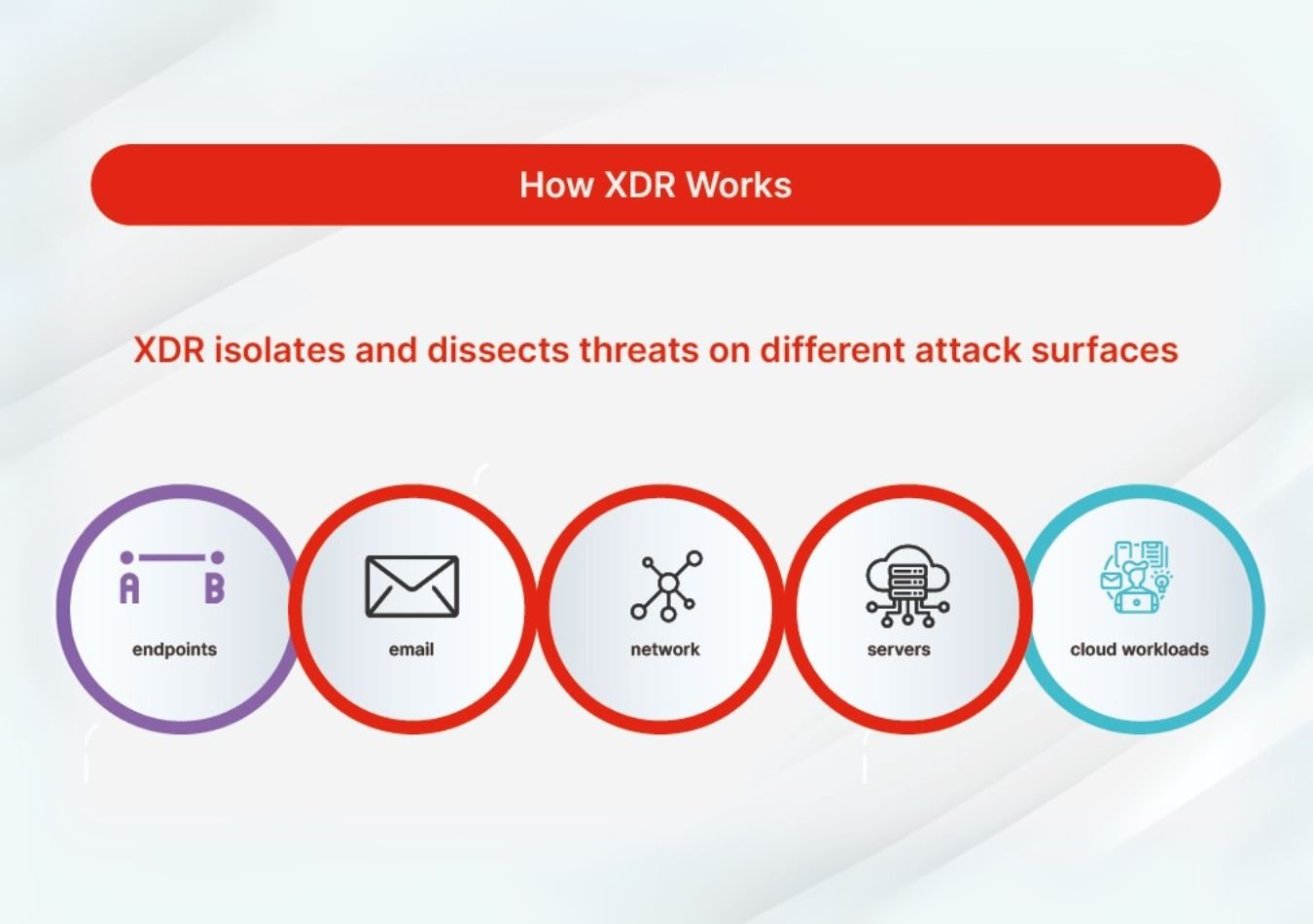Most organisations depend on tools from multiple vendors to build their security infrastructure, often ending up with several standalone solutions that lack integration and shared telemetry.
Poor integration limits the amount of telemetry and intelligence exchanged, making it impossible to create a single, context-rich view of threats. Without full visibility into threats across the entire enterprise, how can your team effectively mitigate risks at scale?
Stealthy threats exploit these gaps, hiding between security silos and unconnected solution alerts, spreading undetected over time. Overwhelmed security analysts struggle to triage and investigate attacks using narrow, disconnected data, leaving organisations vulnerable.
This is where Extended Detection and Response (XDR) transforms security. XDR eliminates silos by taking a holistic approach to threat detection and response. It collects and correlates detections and deep activity data across multiple layers – including email security, endpoint detection, servers, cloud workloads, and network security. With automated analysis of this rich, comprehensive dataset, XDR detects threats faster, enabling security analysts to act quickly and efficiently during investigations.
In this article, we dive into what is XDR, how it enhances threat detection, and its ability to seamlessly integrate solutions across the security stack. By prioritising incident response and empowering analysts with better tools, XDR improves productivity and strengthens your organisation’s overall security posture.

What is Extended Detection and Response (XDR)?
XDR is a cutting-edge security solution that collects threat data from previously siloed tools across an organisation's entire technology stack. This integration enables faster investigation, threat hunting, and response to advanced cyberattacks.
An XDR platform gathers security telemetry from endpoints, cloud workloads, networks, email, and more, delivering a unified approach to cybersecurity.
At its core, the definition of XDR involves collecting telemetry from various security tools, applying advanced analytics to normalised data, and detecting malicious activity. This leads to an efficient response and remediation process, protecting organisations from data breaches and security threats.
XDR ensures organisations can correlate and analyse security data across critical areas like email, endpoints, servers, cloud workloads, and networks. With this comprehensive visibility and contextual insight, businesses can identify, prioritise, and respond to advanced threats. This proactive approach prevents data loss and mitigates potential breaches.

XDR leverages AI-driven automation and threat intelligence to provide a holistic solution. It empowers organisations to stay ahead of evolving threats by offering enhanced visibility, improved efficiency, and faster response times.
As businesses increasingly adopt multi-cloud and hybrid environments, they face more sophisticated cyberattacks and complex security challenges. Unlike Endpoint Detection and Response (EDR), which focuses solely on endpoint security, XDR platforms expand their coverage to protect against advanced threats across diverse domains. These include endpoints, hybrid identities, cloud applications, data stores, and email environments.
By delivering advanced cyberattack chain visibility, integrating AI-powered automation, and utilising broad threat intelligence, XDR significantly enhances the efficiency of Security Operations (SecOps) teams. Organisations benefit from streamlined operations, proactive threat detection, and robust protection against new threats.
What are XDRs Capabilities?
XDR solutions offer advanced capabilities to stop cyberattacks quickly by consolidating multiple tools into a unified platform. This integration breaks down traditional silos, significantly improving cyber threat detection and incident response. Here are some of the key XDR capabilities:
Automatic Disruption of Advanced Cyberattacks
With XDR, organisations can proactively address in-progress attacks using high-fidelity security signals and automated responses. XDR isolates compromised devices and accounts, reducing the incident blast radius. By leveraging these tools, businesses can:
- Lower overall cybersecurity risk.
- Simplify post-incident investigation and remediation.
- Prevent advanced attacks before they escalate.
Cyberattack Chain Visibility
Unlike traditional point security solutions, XDR consolidates alerts from various sources, offering complete visibility into the cyberattack chain. This view allows analysts to detect and remediate sophisticated attacks that might otherwise go unnoticed. Improved visibility:
- Reduces investigation time.
- Enhances the chances of successful remediation.
- Strengthens the overall cybersecurity strategy.
AI and ML Integration for Scalable Cybersecurity
XDR systems leverage AI and ML to enhance threat detection and response capabilities. These technologies empower XDR platforms to:
- Automatically detect and mitigate potential threats.
- Generate behaviour profiles using ML algorithms, identifying suspicious activities for analysts to investigate.
- Scale AI-driven cybersecurity efforts efficiently.
Incident-Based Investigation
With XDR, alerts are correlated into incidents, providing security teams a comprehensive view of potential threats. Analysts can:
- Avoid sifting through scattered data.
- Quickly understand and address cyberthreat activity.
- Enhance productivity and speed up responses.
How does XDR work?
XDR leverages AI-driven security tools and advanced analytics to provide comprehensive protection across an organisation’s entire IT ecosystem. By monitoring multiple domains, XDR identifies and correlates alerts into actionable incidents, prioritising those with the highest risk. This enables security teams to gain a clearer understanding of each attack in its context, allowing for faster and more effective responses.
Collecting and Normalising Data
XDR automatically gathers telemetry data from a variety of sources, including endpoints, networks, cloud environments, and email systems. The system cleans, organises, and standardises the data, ensuring it is consistent and high-quality for accurate analysis. This provides a solid foundation for identifying potential threats.
Parsing and Correlating Data
Using ML and advanced AI capabilities, XDR analyses data in real-time to detect malicious behaviour and cyberattacks. By correlating thousands of alerts into incidents, the system significantly reduces manual workloads for security analysts, enabling them to remediate threats faster and with greater precision.
Facilitating Incident Management
XDR helps security teams by prioritising the severity of incidents providing detailed context to facilitate rapid triage and response. Depending on the risk, the system can:
- Automatically quarantine compromised devices.
- Block suspicious IP addresses or email domains.
- Alert security personnel for manual intervention.
Preventing Future Incidents
Some XDR solutions offer tailored insights into emerging cyber threats and attacker techniques specific to an organisation’s environment by leveraging broad threat intelligence. These insights empower cybersecurity teams to proactively defend against high-risk threats, improving their organisation’s overall resilience against future attacks.
What are XDR Benefits?
XDR delivers a range of benefits that provide enterprises with holistic, flexible, and efficient protection against evolving threats. By unifying their teams, tools, and processes with XDR systems, enterprises can enhance their cybersecurity posture in several key ways.
There are seven key benefits of XDR:
Accelerated Threat Detection and Response
XDR identifies cross-domain threats in real-time and deploys automated response actions. These capabilities help eliminate or reduce the amount of time attackers have access to enterprise data and systems, improving threat response time and reducing potential damage.
Faster SOC Insights
XDR provides the Security Operations Centre (SOC) with AI-powered insights and automation capabilities essential to staying ahead of sophisticated cyber threats. Additionally, with a cloud-based XDR platform, the SOC can scale rapidly and pivot efficiently as cybersecurity threats evolve.
Enhanced Incident Prioritisation
XDR evaluates and highlights high-risk incidents that require prompt investigation. It also recommends actions aligned with key industry regulations and standards and enterprise-specific requirements, ensuring that incident response is prioritised based on severity and impact.
Improved Productivity and Efficiency
With XDR, enterprises benefit from the automation of repetitive tasks and asset self-healing capabilities, reducing manual labour and allowing security analysts to focus on higher-value activities. Furthermore, centralised management tools increase alert accuracy, simplifying the number of solutions analysts need to access for effective threat investigation and remediation.
Increased Visibility
XDR enhances an enterprise's security visibility, providing a clearer understanding of its cybersecurity landscape. By integrating telemetry data from various domains—such as endpoints, email, cloud applications, workloads, and other sources—XDR uncovers hidden cyber threats that might otherwise go unnoticed.
Streamlined SecOps Workflows
By automatically correlating security alerts, XDR significantly reduces the noise in analysts' inboxes, allowing them to focus on more critical tasks. This streamlining of SecOps workflows reduces the time spent on manual investigations and helps security teams respond more swiftly to cyber incidents.
What is the Difference Between XDR and EDR?
When comparing XDR and EDR, it’s essential to understand their unique roles in cybersecurity. EDR solutions focus on protecting endpoints, such as laptops, desktops, and servers, by performing threat prevention, detection, and response through a dedicated endpoint agent.
In contrast, XDR solutions go beyond endpoints, integrating data from multiple vectors, including networks, cloud environments, IAM systems, and applications. By unifying these diverse data sources, XDR enhances threat hunting, enables faster incident response, and improves the overall cybersecurity posture of an organisation. This broader scope makes XDR an advanced evolution of EDR, designed to address today’s complex and dynamic threat landscape.
By leveraging the capabilities of both XDR and EDR, organisations can better safeguard their digital infrastructure and respond to evolving cyber threats.
What is the difference between XDR and SIEM?
When comparing XDR and SIEM, it's important to understand that they offer distinct yet complementary capabilities in cybersecurity.
SIEM solutions are designed to aggregate vast amounts of data from multiple sources, providing deep visibility into an organisation’s IT environment. These systems are ideal for:
- Identifying security threats and unusual behaviour.
- Streamlining log management, incident management, and compliance reporting.
- Supporting security orchestration, automation, and response tools to handle incidents.
However, SIEM systems often require extensive customisation and lack automated attack disruption capabilities, which can limit their speed and efficiency in mitigating threats.
In contrast, XDR platforms are purpose-built for integrating data from sources with prebuilt connectors, offering streamlined implementation. They automatically:
- Collect, correlate, and analyse a richer dataset.
- Enable security teams to prioritise critical events.
- Initiate swift, precise responses to cyber threats.
Unlike SIEM systems, XDR focuses on proactive threat detection and response, helping organisations tackle attacks more efficiently. By integrating XDR with SIEM, organisations can unlock comprehensive detection, analytics, and automated response capabilities.
This combination provides:
- Enhanced visibility across the cyber kill chain, enabling better tracking of attack stages.
- A solid foundation for adopting Generative AI (Gen-AI) in cybersecurity.
- Improved defences across all layers of the digital estate, ensuring robust protection against modern cyber threats.







Comments ( 0 )